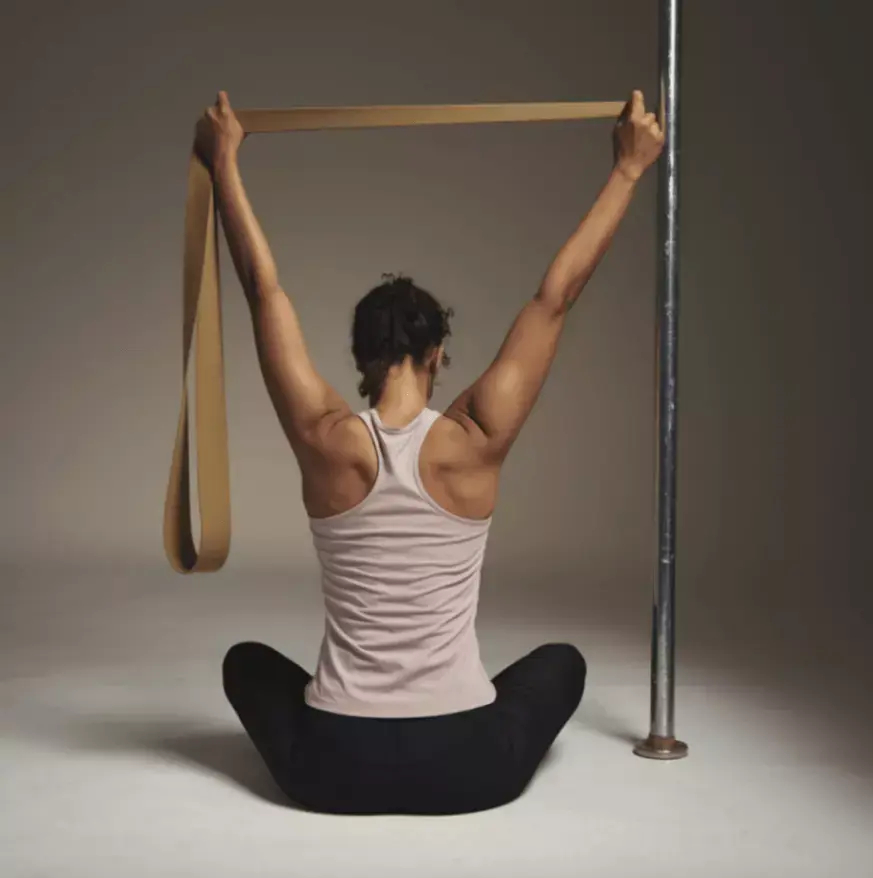Shoulder blade pain can be a clawing monkey on your upper back, making simple daily tasks uncomfortable or downright painful. If you’ve ever dealt with this type of discomfort, you know how disruptive it can be. The good news is that there is a remedy; regular stretching.
In this article, we’ll walk you through some effective stretches and exercises to bring relief and ease shoulder blade pain.
How Shoulder Blade Pain Affects Your Daily Life
Shoulder blade pain can have a significant impact on your daily life. When your range of motion becomes limited, even simple tasks can feel challenging. Reaching for something on a shelf, lifting a grocery bag, or even putting on your clothes might become painful. This restriction can cause frustration and lead to avoiding tasks that normally wouldn’t be an issue.
Sleep is often disrupted as well. Pain in the shoulder blade typically worsens when you lie down or shift positions during the night. These disruptions can prevent restful sleep, leaving you tired and less able to focus the next day.
Shoulder blade pain can also lead to poor posture. In an attempt to avoid the pain, you might start to slouch or hold your body in unnatural positions. Over time, this can make the discomfort worse and lead to problems in other areas like your neck or lower back.
These daily struggles highlight the importance of proper stretches to relieve the tension and restore mobility before it impacts your overall well-being.
Top Stretching Exercises for Shoulder Blade Pain Relief
1. Cross-Body Shoulder Stretch
The Cross-Body Shoulder Stretch is an easy yet effective method to alleviate pain in the shoulder blades. It works by targeting the muscles around your shoulder blade, which often become tight or strained.
To perform the stretch properly:
-
Reach one arm straight across your chest.
-
With your opposite hand, gently grasp the elbow or upper arm.
-
Slowly pull your arm closer to your body without forcing or overstretching.
-
It’s important to hold the stretch for up to 30 seconds, then switch arms.
By gently applying pressure, you increase the stretch’s effectiveness without risking injury. This helps to improve mobility in the shoulder joint, which can reduce the discomfort you feel around your shoulder blade area.
2. Towel Stretch
The Towel Stretch is a simple and effective technique for relieving discomfort in the shoulder blade area. You’ll only need a towel or a similar object like a belt or band.
To perform the stretch, hold the towel overhead with both hands. Then, pull one end of the towel down behind your back with your opposite hand while keeping the other arm straight.
This movement creates tension across your shoulder and shoulder blade area. As you pull down, the stretch helps increase your range of motion by pulling your shoulder into a deeper position. It targets the muscles and tendons connected to the shoulder blade, which are often tight or stiff because of poor posture or overuse.
The benefits of the Towel Stretch include:
-
Relieving tightness in the shoulder blade and surrounding muscles.
-
Reducing pain by loosening the area and improving blood flow.
-
Improving mobility for better shoulder movement during daily activities.
-
Increasing flexibility, making it easier for you to perform tasks that involve reaching or lifting.
3. Finger Walk Stretch
The effective, easy-to-do Finger Walk Stretch helps loosen shoulder blade tension while promoting better shoulder mobility.
To perform the movement, stand facing a wall and position yourself close enough so your arm can comfortably reach it. Place your fingertips on the wall at about waist height. With a slight bend in your elbow, begin “walking” your fingers up the wall, one step at a time.
As your hand moves higher, you’ll feel your shoulder blade engage and lift. This movement helps loosen tight muscles in the area, which can reduce pain around the shoulder blade. The key is to listen to your body—if you feel any discomfort, slow down and ease into the stretch.
Gradually, this stretch might also help improve your shoulder’s range of motion, which is often restricted by pain or stiffness. By gently increasing how far you can lift your arm, you allow for greater flexibility, which can prevent future tension build-up.
4. Armpit Stretch
The Armpit Stretch is an effective way to target the muscles around and beneath your shoulder blade. While simple, it can relieve tension in this area and reduce pain when done correctly.
To begin, raise one arm overhead and place your hand on the opposite shoulder. This setup prepares the shoulder joint for a deeper stretch. From there, gently lean forward. As you lean, you’ll feel the stretch deepen, specifically targeting muscles like the serratus anterior and latissimus dorsi under and around the shoulder blade.
This stretch works by loosening tight muscles that contribute to shoulder blade pain. When performed consistently and with proper form, it can help ease discomfort and improve shoulder mobility. You can use stretching apps with tracking features and visual guidance, such as WeStretch, to ensure this.
5. Pendulum Stretch
The Pendulum Stretch is a simple exercise that can help ease shoulder blade pain by loosening up the muscles around your shoulder.
To start, find a sturdy surface like a table or chair and lean forward slightly. Let your arm hang down naturally without any tension.
Once you’re in position, gently start to swing your arm in small circles. Keep the movement slow and controlled. This motion helps to reduce tension by getting the muscles in your shoulder and around your shoulder blade to relax. You can alternate between swinging in clockwise and counterclockwise circles to engage different muscles.
“I love this stretch because it’s gentle and perfect when I’m dealing with pain or stiffness. Plus, it’s easy for beginners since it doesn’t put much pressure on the shoulder.”
Exercise Smarter with WeStretch: Your All-in-One Stretching Assistant
A consistent full-body stretching routine is essential for improving flexibility, supporting injury prevention, and enhancing overall well-being. Carefully following simple yet effective stretches targeting the hamstrings, hip flexors, back, quads, chest, and shoulders, individuals of any fitness level can reap the benefits.
Regular stretching, with attention to proper form and consistency, can help you move more freely, recover faster, and feel better in everyday activities.
Looking for a way to add some fun to your stretching routine? Check out WeStretch—an app that’s like your own personal stretch coach! With tailored plans, easy-to-follow demos, and progress tracking, it’s got everything you need to keep you limber and on point. Ready to get flexible? Sign up today and let’s get stretching!
 FAQ
FAQ
How do you stretch out shoulder blade pain?
To stretch out shoulder blade pain, try exercises like the doorway stretch, where you place your arms on either side of a doorframe and gently lean forward. You can also perform shoulder rolls, cat-cow stretches, and child’s pose to release tension.
Another effective movement is the thoracic extension, where you lie on a foam roller and extend your back. These stretches help improve flexibility, reduce pain, and promote muscle relaxation.
How do you make shoulder blade pain go away?
To relieve shoulder blade pain, focus on gentle stretching and strengthening exercises. Try shoulder rolls, neck stretches, and doorway stretches to improve flexibility. Strengthening exercises like scapular squeezes and finger walks help support the muscles around your shoulder blades.
Consistency is key, so perform these exercises regularly, and always listen to your body to avoid overstraining.
How do you target your shoulder blade with stretches to relieve pain?
To target your shoulder blade and relieve pain, try shoulder rolls, wall angels, or the cat-cow stretch. Shoulder rolls involve rotating your shoulders in circular motions to release tension. Wall angels help improve posture, gently mobilizing your shoulder blades. The cat-cow stretch moves your spine between flexion and extension, loosening tight muscles around the shoulder blades. Always move slowly and stop if you feel sharp pain.
How do I unpinch my shoulder blade?
To unpinch your shoulder blade, try exercises like shoulder blade squeezes, doorway stretches, and cat-cow stretches. Shoulder blade squeezes involve pulling your shoulder blades together while keeping your shoulders relaxed. Doorway stretches help open up the chest and relieve tension in the upper back. Cat-cow stretches promote spine mobility and ease pressure around the shoulder blades.
Regular stretching and maintaining good posture can significantly reduce pain and discomfort.
What are the best stretches for shoulder blade pain?
Some of the best stretches for shoulder blade pain include the cross-body shoulder stretch, towel stretch, pendulum stretch, cat-cow stretch, and seated spinal twist. These stretches target the muscles around the shoulder blades, helping to improve flexibility and relieve tension.
Aim to hold each stretch for up to 30 seconds, repeating 2-3 times on each side. Always stretch gently to avoid injury and consult a doctor if the pain persists.






